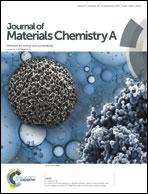Cooperative assembly of an active layer utilizing the synergistic effect of a functional fullerene triad as an acceptor for efficient P3HT-based PSCs†
Abstract
We report the cooperative assembly of the fullerene-styrene cyano-(octyloxy)benzene triad (PCBB-CN-C8) and poly(3-hexylthiophene) (P3HT) to form an active layer of polymer solar cells (PSCs) with a well-defined microstructure and an enhanced stability of morphology. A favorable synergistic effect of the three functional moieties (C60, styrene cyano and tri(octyloxy) chains) in PCBB-CN-C8 can not only induce P3HT to assemble into long-range ordered periodic fibrils giving an interpenetrating network but also can form PCBB-CN-C8 crystallized domains without the need for external treatment. The characterization of the microstructure and morphology of P3HT:PCBB-CN-C8 blend films by two-dimensional grazing incidence X-ray diffraction, transmission electron microscopy and atomic force microscopy reveals that the P3HT fibrils possess a highly crystallized lamellar phase, and the spacing of the periodic P3HT fibrils is approximately 10 nm depending on the PCBB-CN-C8 crystallites, which fill in the P3HT interpenetrating network. Bulk heterojunction PSCs based on P3HT:PCBB-CN-C8 exhibit an improved open-circuit voltage and an excellent power conversion efficiency of 4.20%, which is greater than that of control PSCs based on P3HT:PCBB-C8 and the devices based on P3HT:PCBM with thermal annealing. We believe that the cooperative assembly of the active layer using the synergistic effect of the fullerene triad is a general approach that can be used to develop external treatment-free technology and improve the morphological stability of the active layer and photovoltaic performance.


 Please wait while we load your content...
Please wait while we load your content...